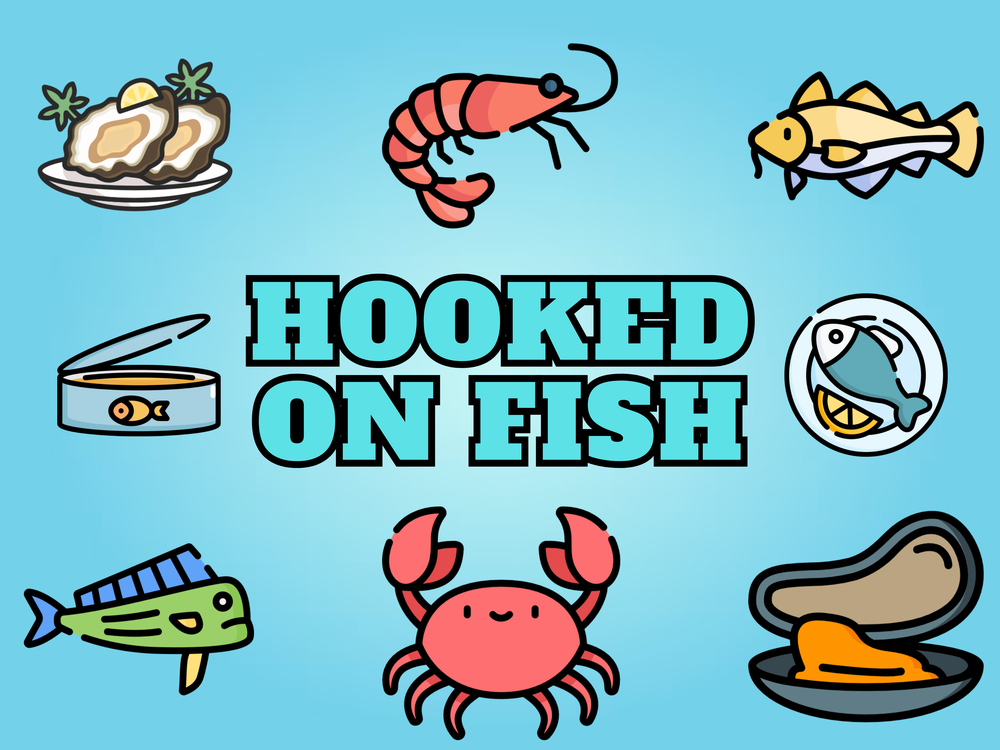
Introduction
Fish and seafood are a highly nutritious class of foods. They're typically categorized by being either lean or fatty. Both are nutritious, being high in protein, vitamins and minerals, such as vitamin B12, phosphorus, and selenium. Fish are unique in that they contain vitamin D which is rarely found in food, as it's predominantly obtained via sunlight. Optimal vitamin D levels are linked to stronger bones, improved mood, and a healthy heart.
The star nutrient of fish is omega-3 fatty acids, found mainly in fatty fish. Omega-3s are a type of essential polyunsaturated fat that must be consumed. The 2 main types, EPA and DHA are shown to be beneficial for both cardiovascular and brain health. Proper consumption of omega-3s is also linked to reduced inflammation, lower blood pressure, lower rates of heart attack and stroke, a reduced risk for Alzheimer's, and lower rates of depression.
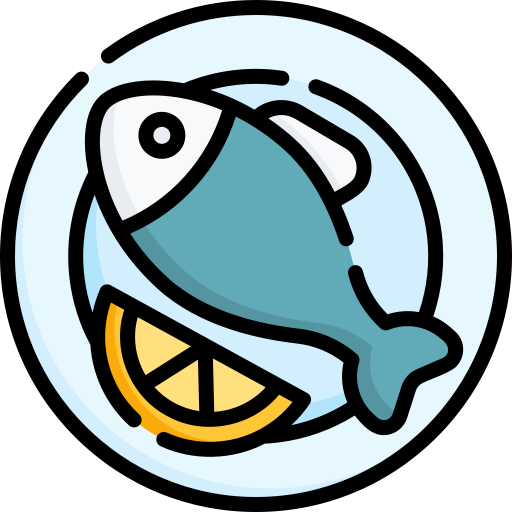
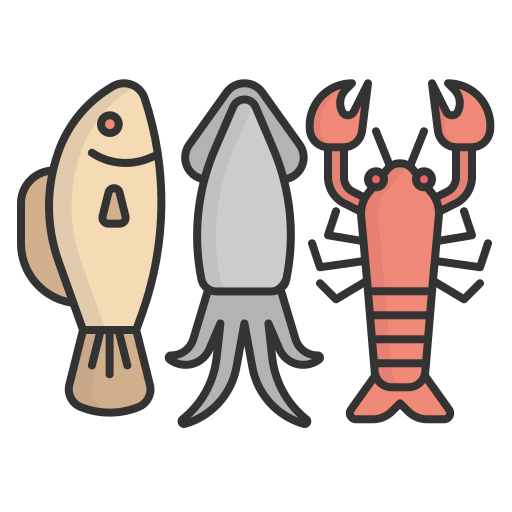
Other Posts in this Series
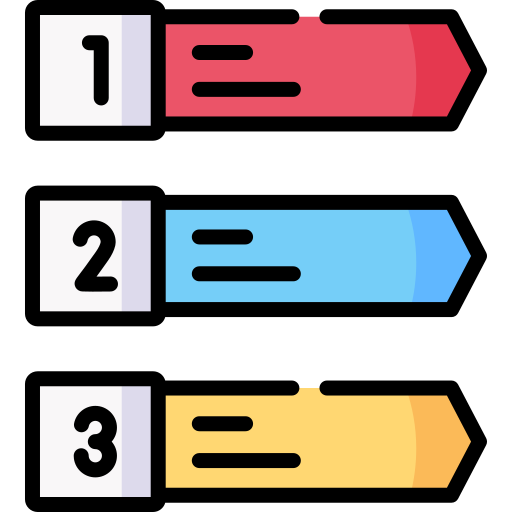
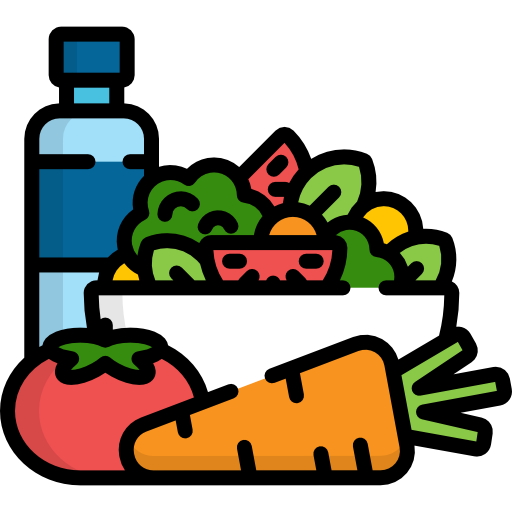
Contents

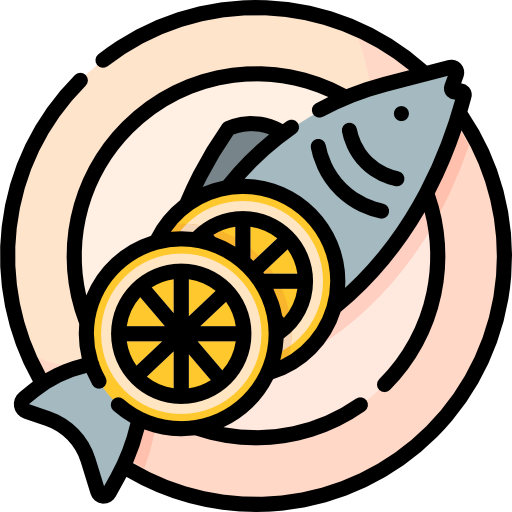
Tiny but mighty, anchovies are a moderately high protein source that are rich in omega-3 fats and calcium. Gram for gram, anchovies are one of the richest sources of omega-3s, meaning that they're also one of the fattiest fishes. Their B3 content helps in converting food into energy, and anchovies are also a good source of B2, B12, choline, and selenium. Anchovies are low in mercury, and can come packed in either oil or water. Either make sure to get water packed anchovies, or rinse off the oil before eating.
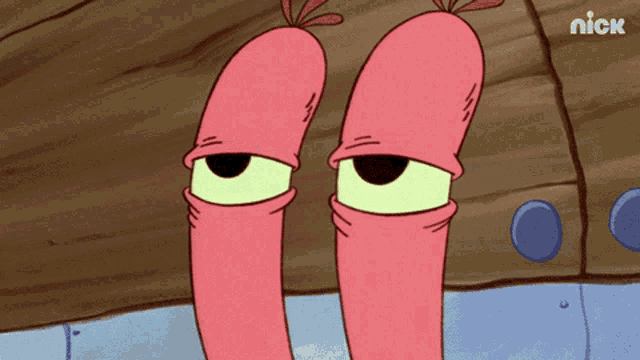

Serving Size: 1.6 oz (45 g)
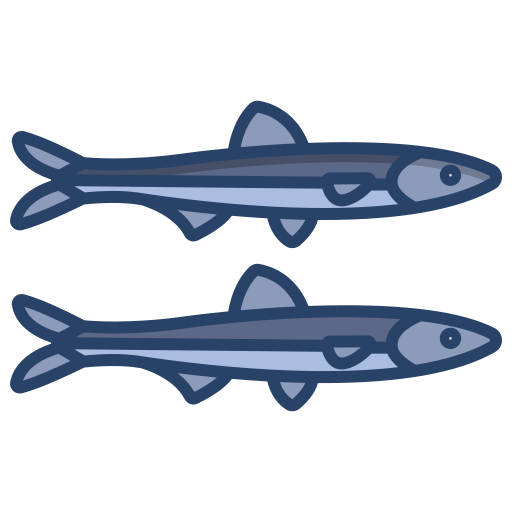
Clams are one of the richest natural sources of vitamin B12 you can find. A typical 3 oz (85 g) serving of clams provides 450% of the RDA of B12, or 10.79 mcg. Vitamin B12 is an essential B vitamin that's vital for energy production, regulating mood, forming red blood cells, and promoting a healthy brain. Clams are also rich in vitamin A, choline, iron, phosphorus, and selenium. They provide lean protein, as clams are pretty low in fat.
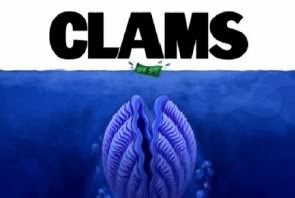
Canned clams are a fairly common ingredient in my pantry for how cheap and easy they are. My main use is to make my Pasta with Healthier Clam Sauce, which combines red lentil pasta with a lean clam sauce, free of tons of butter and oil typically found in most clam sauce recipes. I also have some extremely non-traditional clam chowder recipes, which pack more vegetables, fiber, and protein than the classics, without being a butter or cream bomb. Check out my (I'm Banned From) New England Clam Chowder and my (No Longer Allowed In) Manhattan Clam Chowder.
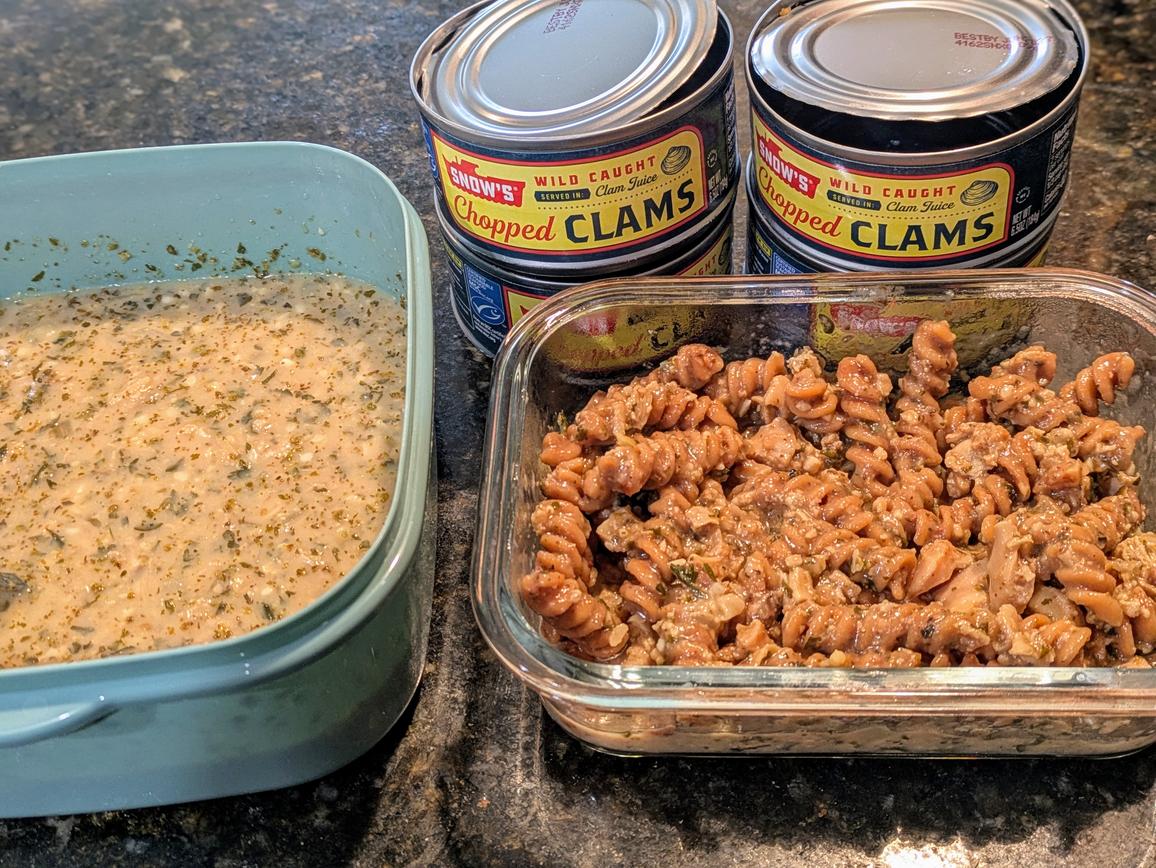
Serving Size: 3 oz (85 g)
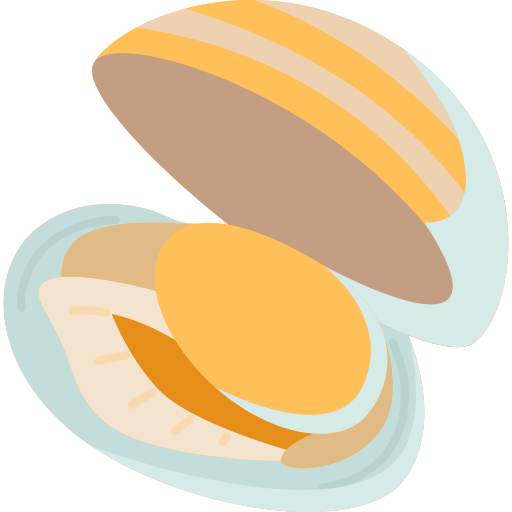
Cod is a mild, lean white fish that’s low in calories and fat, but still provides solid protein. It’s a decent source of B12 and phosphorus, but is quite low in omega-3s. Cod's choline content is beneficial for memory and brain development, and the selenium aids as an antioxidant. That whole 'lean' argument goes right out the window when you start talking about fish and chips though, which is breaded and fried, adding inflammatory fats and carbs to an otherwise inoffensive and healthful fish. Fried cod is fine to enjoy on occasion, but it's not going to offer any health benefits when preparred as such.
Serving Size: 3 oz (85 g)
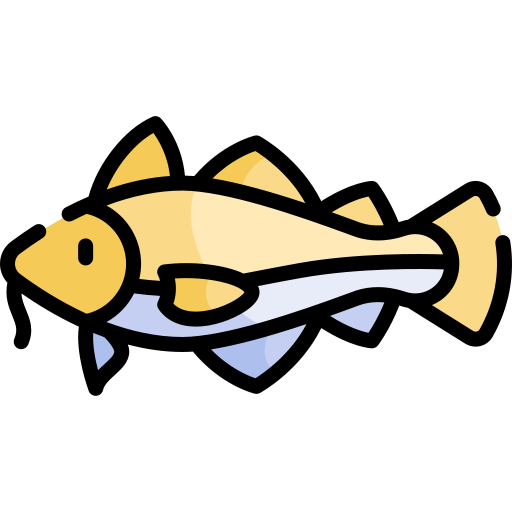
Crab meat is a high protein shellfish that provides copper, phosphorus, zinc, and vitamin B12. Along with salmon, crab is a rich source of the carotenoid astaxanthin, which can promote healthy brain aging and raise HDL levels. Like other shellfish, it’s nutrient dense, low in calories, and low in mercury, but can be high in sodium.

Serving Size: 3 oz (85 g)
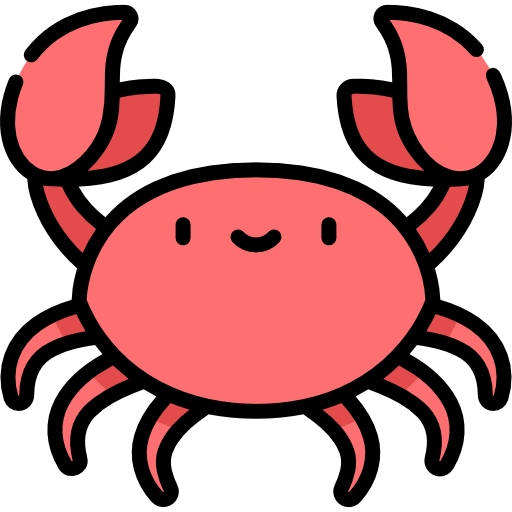
Cuttlefish is notably one of the best sources of both iron and selenium, as well as being a fantastic source of vitamin B12 and riboflavin. It has one of the highest protein to calorie ratios of any fish on this list, meaning it's a great lean protein source. Not only is cuttlefish low in mercury, but the myriad of vitamins and minerals found in cuttlefish aid in transfer of oxygen (iron), production of red blood cells (riboflavin), and the promotion of a healthy immune system (copper).
Serving Size: 3 oz (85 g)
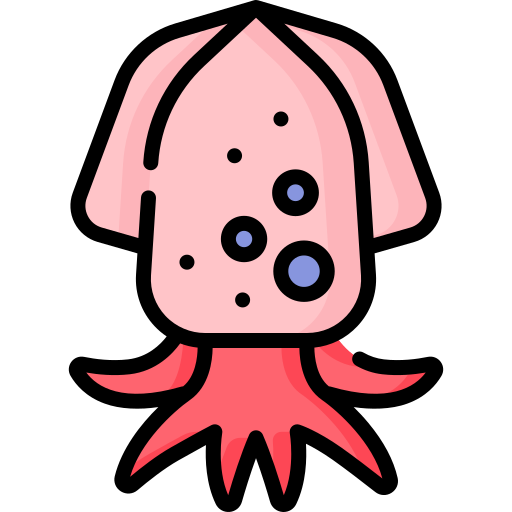
Haddock is another mild white fish that’s lean and protein rich. It's main nutrient is vitamin B12, but is also a good source of niacin, vitamin B6, and selenium without being high in fat. At 16 g of protein and 74 calories per 100 g, haddock is a good lean white fish that also can promote brain health via choline.
Serving Size: 3 oz (85 g)
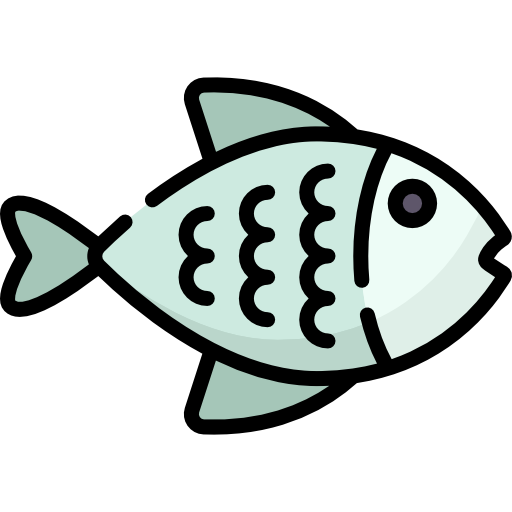
Halibut is a firm white fish that’s high in protein and a good source of the minerals selenium and phosphorus. Most notably, halibut is a great food source of vitamin D, where a 3 oz (85 g) serving supplies 4.0 mcg (20 %) of vitamin D. Halibut is also high in many B vitamins, including B3, B6, and B12, as well as being a good source of choline.
Serving Size: 3 oz (85 g)
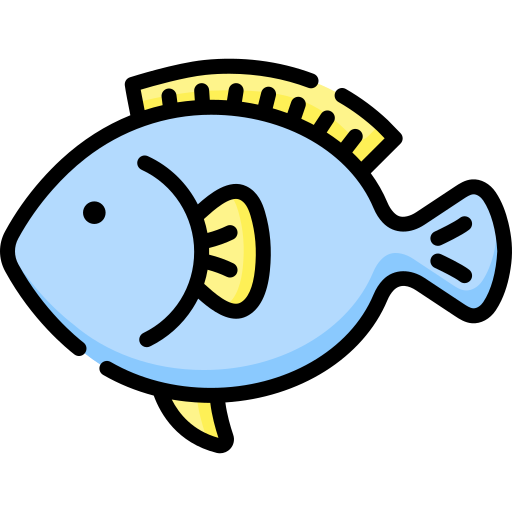
It's been a while since we've looked at a fatty fish (all the way back up at anchovies). Herring is an oily fish loaded with omega-3s and B12. Herring has just as much vitamin D as the aforementioned halibut, while also being a rich source of riboflavin, niacin, B6, phosphorus, and selenium, which aids in thyroid function and immune system support.
Serving Size: 3 oz (85 g)
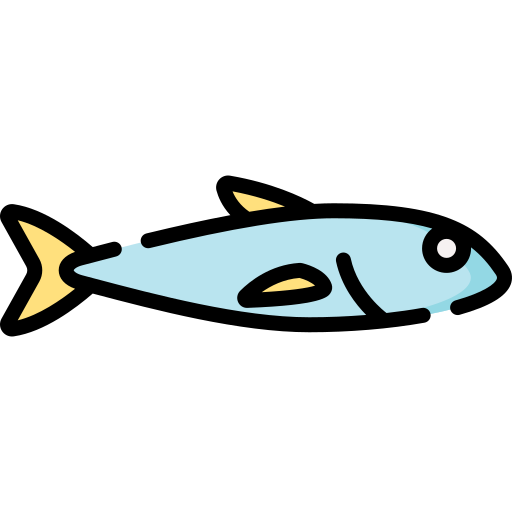
Lobster (pronounced 'lahbstah') is another lean seafood, meaning it's low in fat and high in protein. It supplies vitamin B5, vitamin B12, and zinc. Moreover, lobster is one of the highest sources on this list of both copper and selenium. A 3 oz (85 g) serving of lobster can contain all of your daily minimum of copper and selenium on its own. Most of its calories come from protein, with 14 g of protein, 1 g of fat, and 65 calories in one serving.
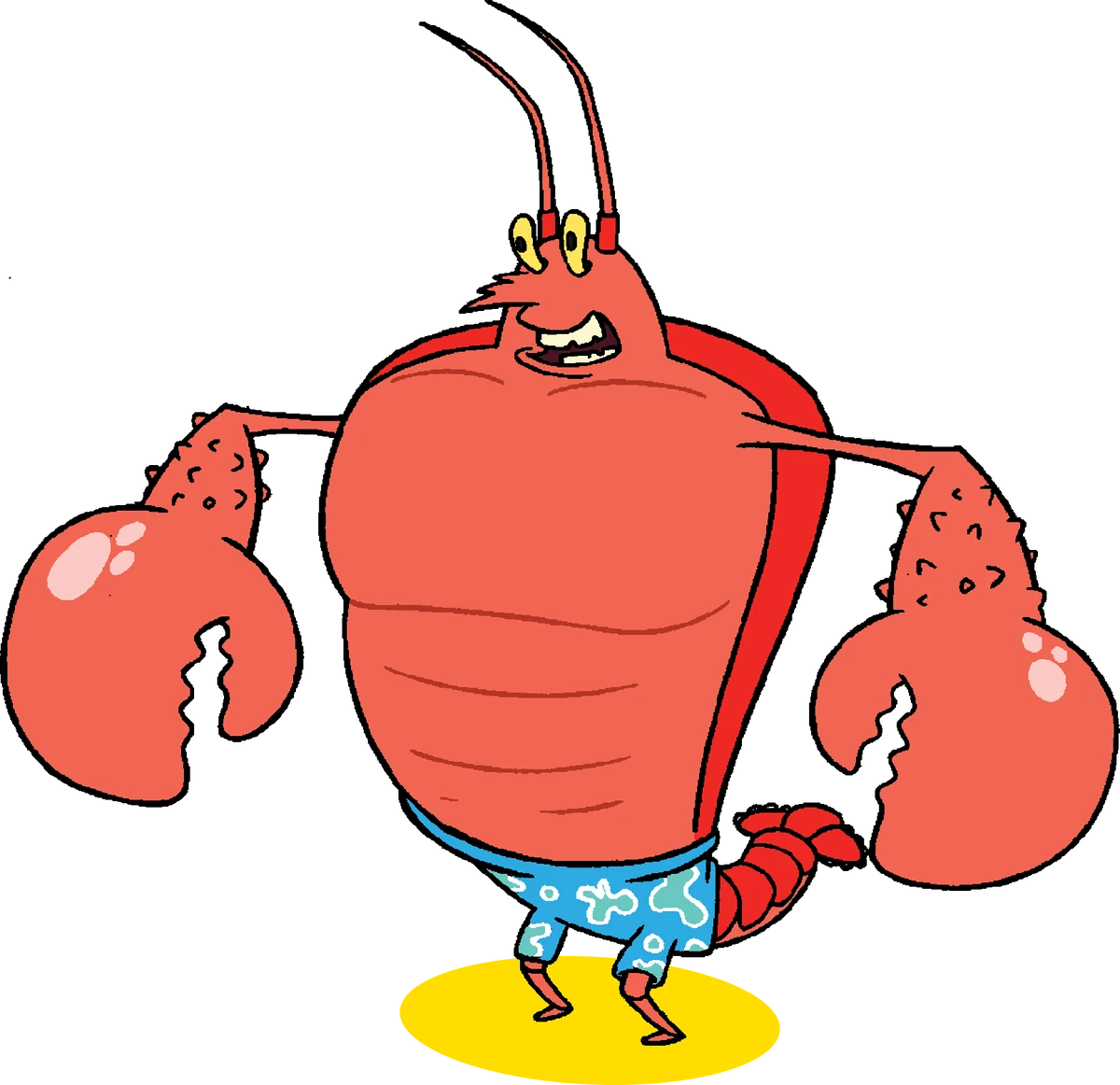
Serving Size: 3 oz (85 g)
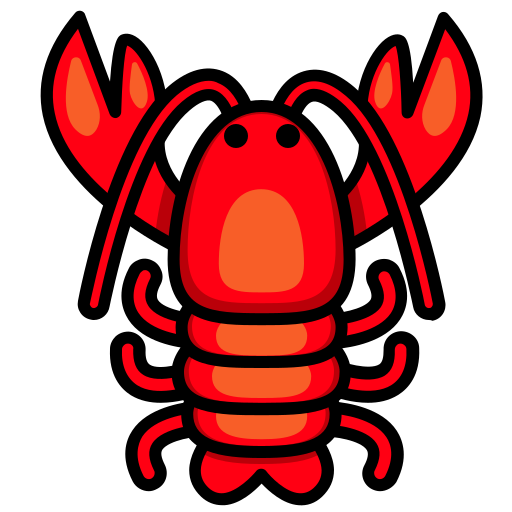
Mackerel is another fatty fish, one of the fattiest foods on this list, meaning it's rich in omega-3 fats. Mackerel is also one of the richest sources of vtiamins D and B12, as well as being a good source of vitamin A, riboflavin, niacin, choline, phosphorus, and selenium. Mackerel is low in mercury, and also a good source of magnesiun, helping to improve the function of nerves and muscles. It’s one of the most nutrient-dense fish available, and conviently comes canned in water for a cheap and easy protein source.
Serving Size: 3 oz (85 g)

Mahi-mahi is a lean, firm fish that’s lower in fat than salmon or mackerel, but still high in protein and selenium. Mahi-mahi is also a good source of B vitamins, notably B3, B5, B6, and B12. Compared to many other fish though, mahi-mahi is a little less nutritious, having a lower micronutrient content, while also having moderate levels of mercury.
Serving Size: 3 oz (85 g)
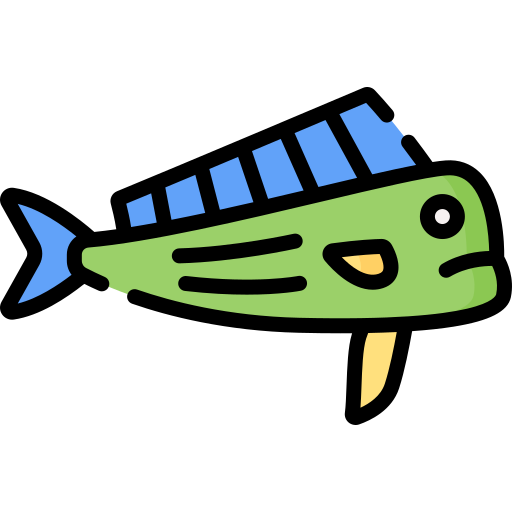
Mussels are a shellfish packed with B12, about as much as clams, which helps in the production of DNA and RNA, improving cell metabolism, and increasing energy levels. Mussels are also a great source of iron and selenium, while also being a moderate source of omega-3 fats despite being very lean. They are a bit lower in protein compared to some other fish options, as mussels do uniquely contain some carbs.
Serving Size: 3 oz (85 g)
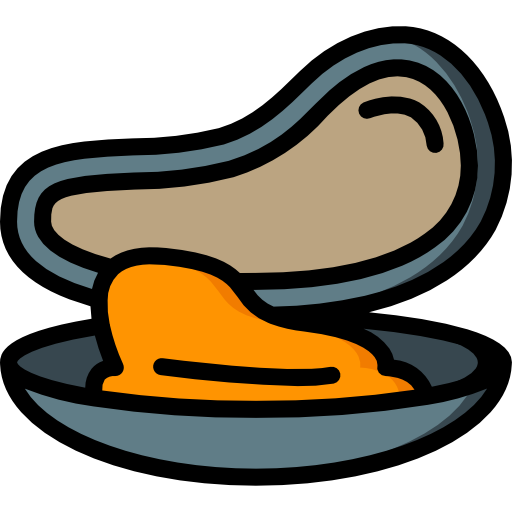
Octopus is lean and high in protein, with significant concentrations of copper and selenium. It has a similar macro-nutrient content to mussels, but it's micro-nutrients are a bit different. Outside of beef liver, you really can't find a better source of vitamin B12 than octopus. Octopus have even more B12 than clams or mussels, aiding in the production of APT, metabolism of cells, synthesis of DNA, and improvement of mood, cognition, and memory. A 3 oz (85 g) serving of octopus contains 17.0 mcg (708 %) vitamin B12, which is more than what you'd get in a multivitamin! And despite the name, Squidward is an octopus, not a squid.
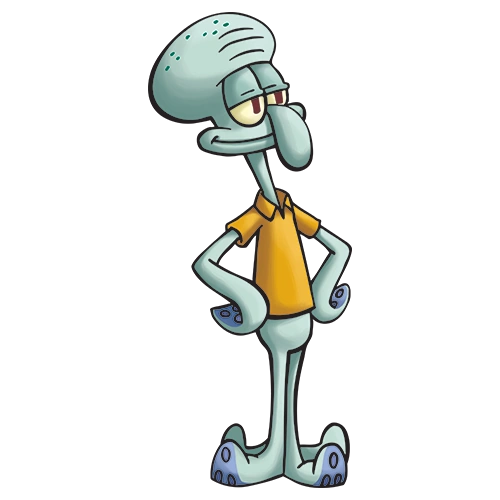
Serving Size: 3 oz (85 g)
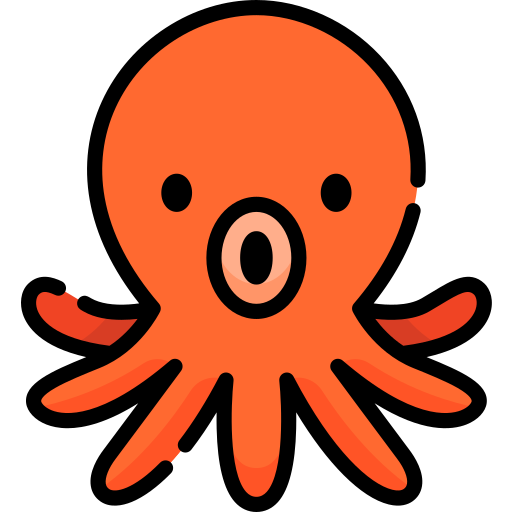
Oysters are famous for being one of the richest food source of zinc, which supports proper wound healing and protein synthesis, as well as iron, which aids in the production of ATP and transfer of oxygen. Moverover, the high copper content of oysters aids in the absorption of iron. They provide B12 and some omega-3 fats, more than any other shellfish. Osyters are the lowest calorie food on this list, but also the lowest in protein and one of highest in carbs.
Serving Size: 3 oz (85 g)

Salmon is the poster child for fatty fish, and for good reason. It's prized for its omega-3s, vitamin D, selenium, and protein. Salmon also contains a myriad of B vitamins, notably B1, B2, B3, B5, B6, and of course B12. But where salmon really shines is in its omega-3 content. A 3 oz (85 g) serving of raw salmon contains nearly 1 g of DHA, and about 0.3 g of EPA. Moreover, salmon, along with crab, is a good source of astaxanthin, which may benefit brain health.
While I love salmon, I don't have too many recipes with it because it can be quite expensive. As such, salmon is more of a treat for myself. I'll typically do something similar to my Air Fried Tilapia from Frozen but with a salmon filet. For some dedicated salmon recipes, you can also check out my Simply Baked Salmon and Crunchy Salad or my Roasted Salmon and Sprouts with Tzatziki. For a more affordable option, salmon comes canned as well, just like tuna. Canned salmon can be used in any way you would use canned tuna, and I even put it on my Date Night Superfood Bowls.

Serving Size: 3 oz (85 g)
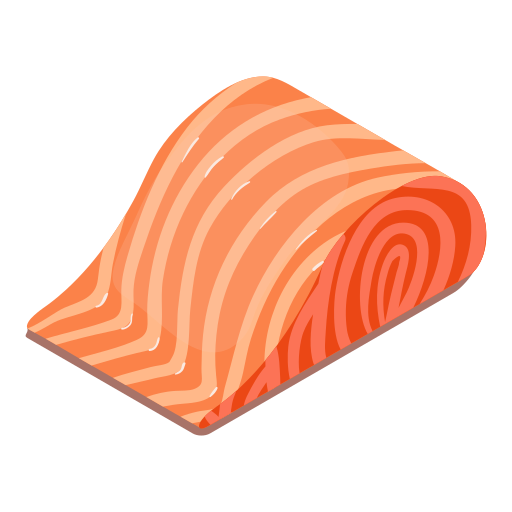
Is Sardine Girl Summer still a thing? Sardines are small but nutrient dense, offering omega-3 fats, protein, and vitamin D. It's phosphorus content aids in the production of DNA and RNA, and calcium promotes strong teeth and bones. Sardines have a very similar omega-3 to omega-6 ratio as salmon, but with more EPA (0.5 g) and less DHA (0.7 g)
Sardines come in convienent cans, and can be found for around $1 per serving. Sardines are probably the best bang for your buck fish in terms of nutrition for the cost. For the ultimate blend of healthy fats, check out my Brain Boosting Bowl which combines together sardines and avocado for plenty of protein and heart healthy monounsaturated fats.
Serving Size: 3 oz (85 g)

Scallops are a low calorie and moderate protein shellfish that are low in fat. They contain a fair amount of B12, phosphorus, and selenium, though they are lacking quite nutritionally compared to nearly other fish. Scallops are a fine choice that you can't go wrong with, but nothing nutritionally stands out about them.
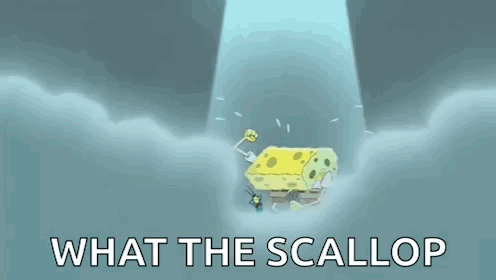
Serving Size: 3 oz (85 g)
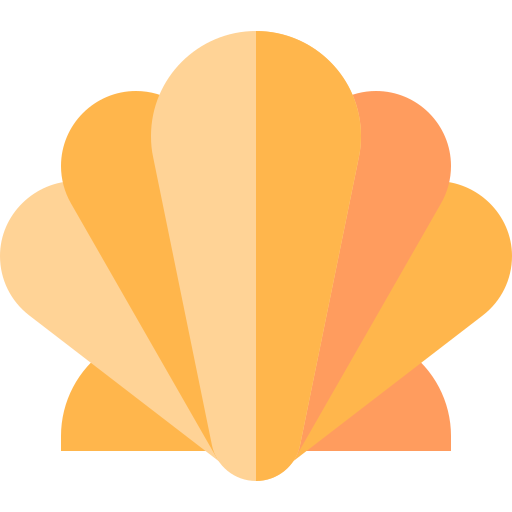
Shrimp are low in calories and high in protein. They provide selenium, B12, and a very small amount of omega-3 fats. Shrimp also have some of the carotenoid astaxanthin, though you'll find more in salmon. Shrimp is a similar story to scallops; they're certainly not bad for you in any way, but there are many other fish that offer far more in terms of vitamins and minerals.

Despite this, shrimp might just be my favorite seafood, but that's probably because I grew up eating it often. It's super quick and easy to cook, tastes great, and is very versatile. I have a couple of different shrimp recipes, all variations of shrimp dishes I ate growing up. There's Shrimp Fra Diavolo, a shrimp dish with a spinach and spicy tomato sauce. Next up is Gluten Free Shrimp Oreganata, a healthier alternative utilizing a homemade gluten free breadcrumb mix. Finally, there's Grilled Shrimp Skewers, my favorite for a barbeque.
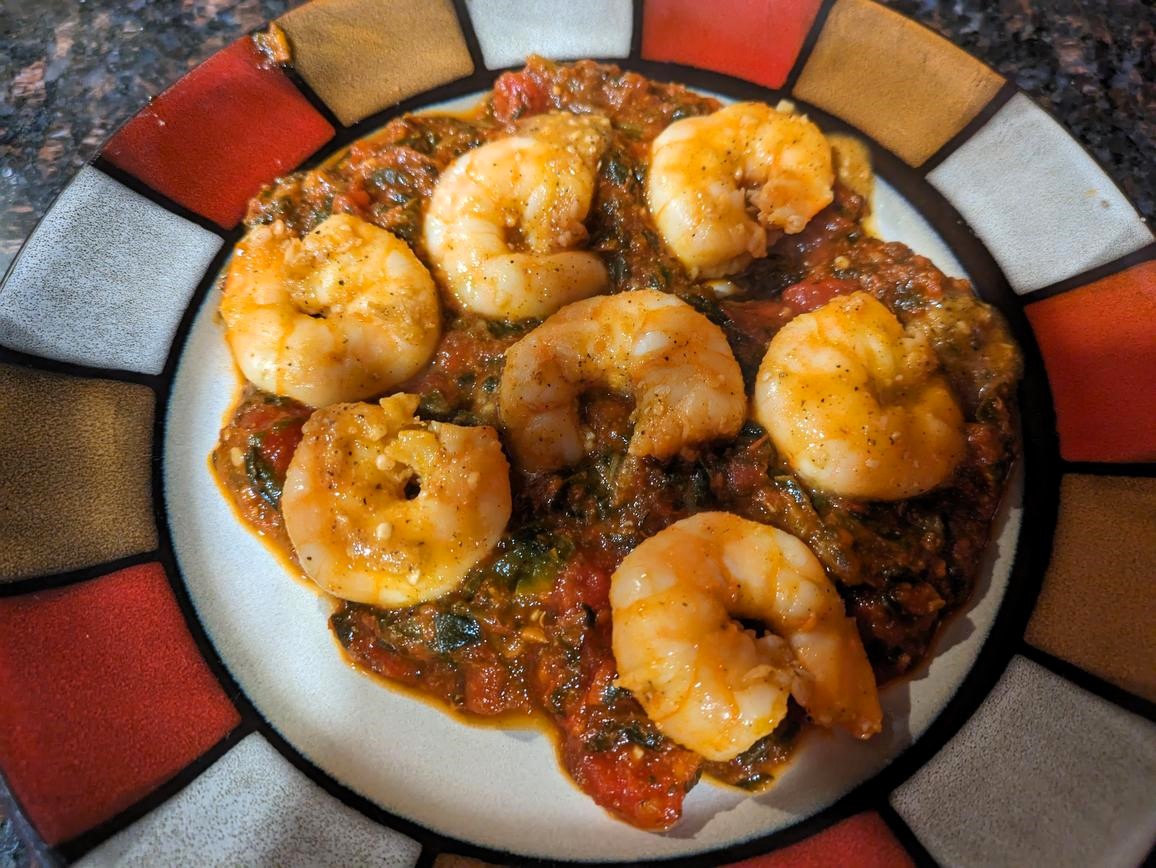
Serving Size: 3 oz (85 g)
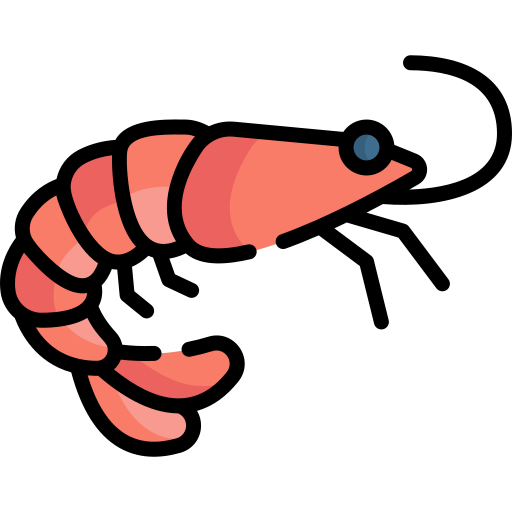
Squid (or calamari) is a lean fish, though it is lower in protein compared to many other fish. It is a great source of copper, selenium, B12, riboflavin, and niacin. That whole 'lean' argument goes right out the window when you start talking about fried calamari though, which is breaded and fried, adding inflammatory fats and carbs to an otherwise inoffensive and healthful fish. Fried calamari is fine to enjoy on occasion, but it's not going to offer any health benefits when preparred as such. And despite the name, Squidward is an octopus, not a squid.
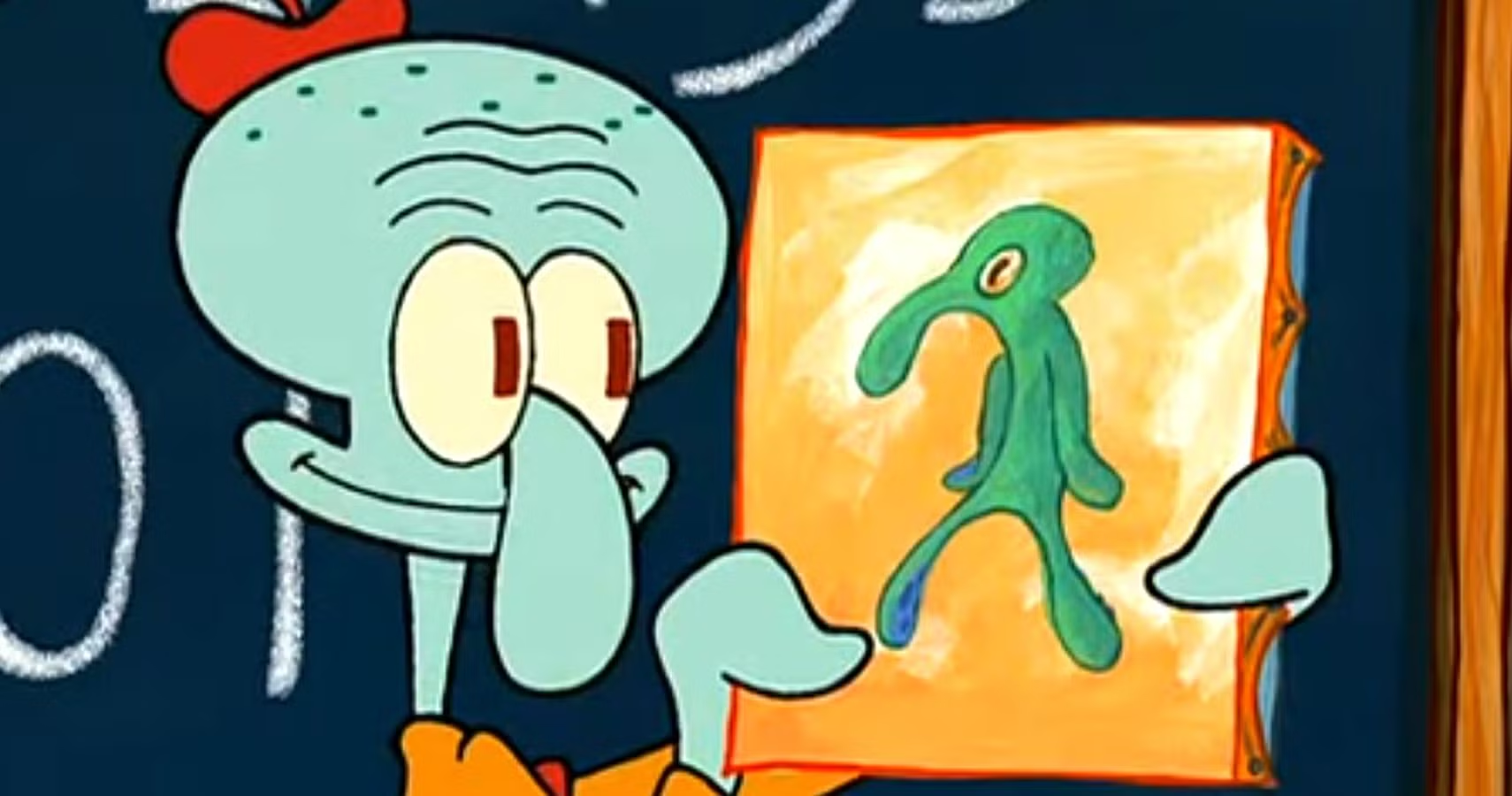
Serving Size: 3 oz (85 g)

Tilapia is a very lean, inexpensive white fish that’s high in protein but relatively low in omega-3s. Like most fish, it does contain some vitamin D, but tilapia is also a fine source of many B vitamins, including B3, B5, B6, and B12. Tilapia is also a rich source of selenium, as well as providing some phosphorus.
Tilapia is typically the cheapest fish in the store; I can find it for about $6.50 per pound. It's a fine white fish that's a super lean source of protein. I like to just dump some random spices on my tilapia and air fry it for a quick protein source; check out my Air Fried Tilapia from Frozen for cooking times.
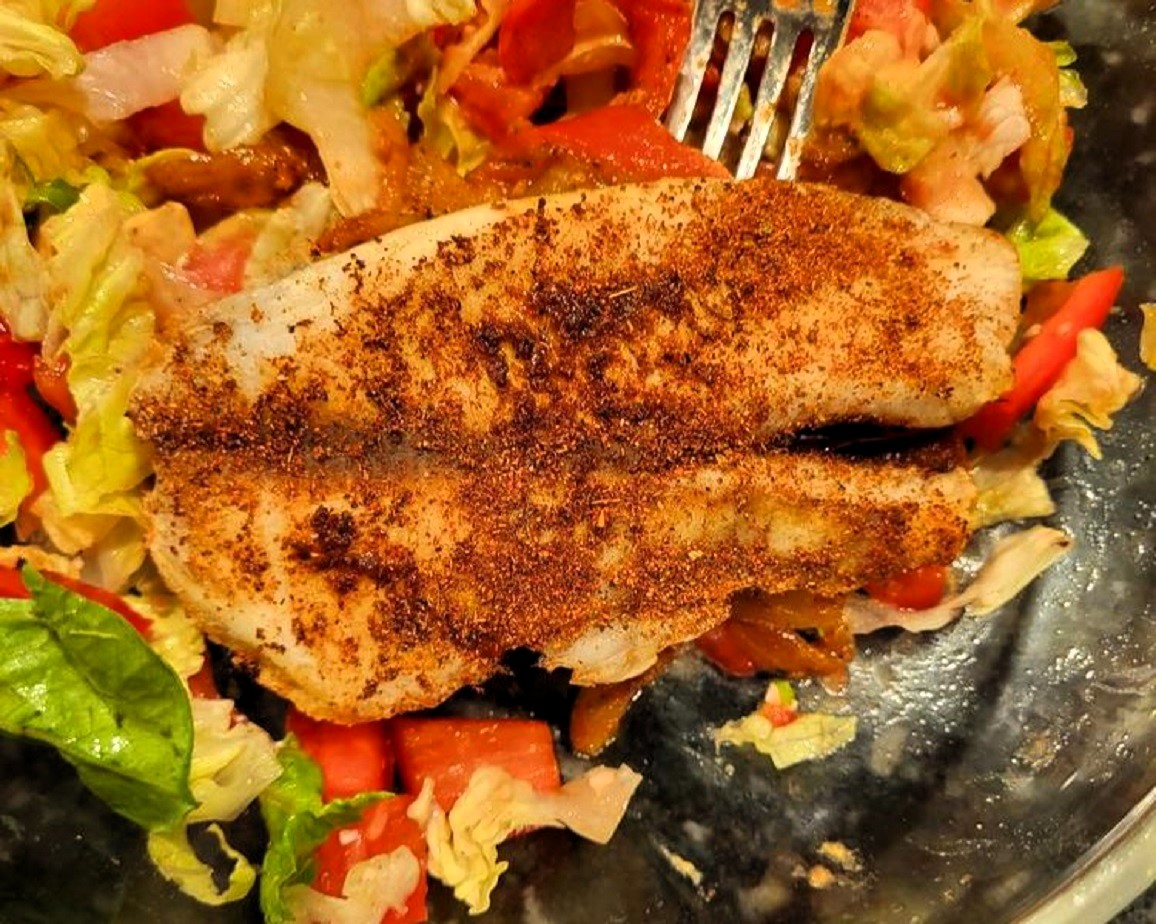
Serving Size: 3 oz (85 g)

Trout is a midly fatty fish with a good source of omega-3s, containing about 0.5 g of combined DHA and EPA per 3 oz (85 g). It's fattier than lean white fish, like tilapia, cod, or haddock, but leaner than most fatty fish, such as salmon, sardines, and mackerel. Wild rainbow trout is a fantastic source of vitamin B12, and is also high in other B vitamins, such as B3, B5, and B6. Trout is however lower in both phosphorus and selenium compared to other fish on the market.
Serving Size: 3 oz (85 g)
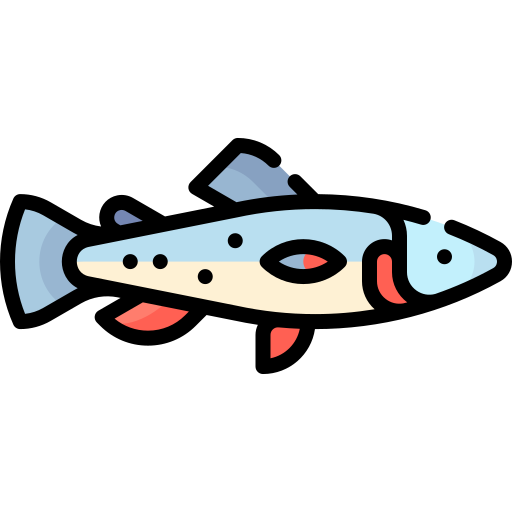
Tuna is a versatile, lean fish that’s especially high in protein, B12, niacin, and selenium. Fatty varieties (like bluefin) have more omega-3s, while canned tuna is lean and very budget friendly.
Canned tuna can be packed in oil (yuk) or water (my preference), offering an extremely cheap, lean, and versatile protein source. According to my calculations in my post What is the Best Protein Source?, canned tuna came out on top as the best option in terms of protien quality, quantity, and low cost. Just be mindful that canned tuna contains moderate levels of the heavy metal mercury. It's not recommended to consume canned tuna more than twice a week.
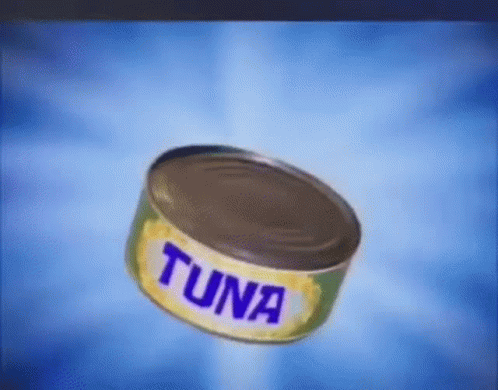
Canned tuna is quick and requires no preparation, making it super easy to crack open a can and throw on whatever you like. Most of the time, I'll put a can of tuna on top of my salad as a protein source, but sometimes I'll make myself a tuna salad. I have two recipes; my Greek yogurt based No-Mayo Tuna Salad, and my avocado based Avocado Tuna Salad.
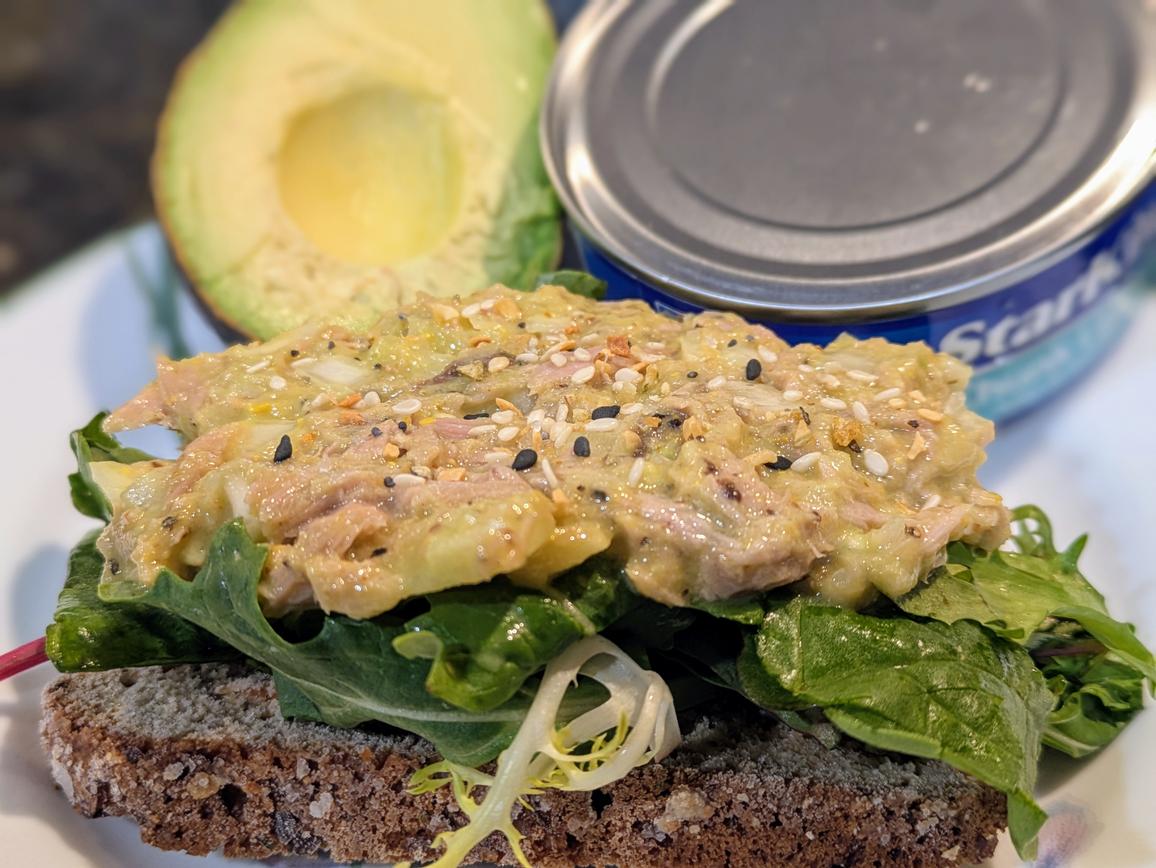
Serving Size: 4 oz (113 g)
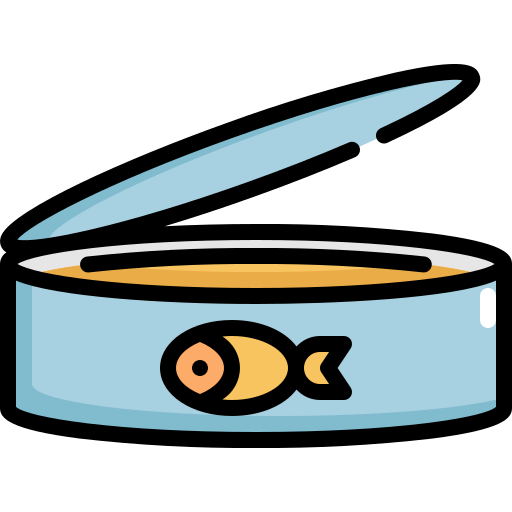
Nutritional Comparison
Scroll to the right to read information about every variation

References
This post may contain affiliate links
Fish and seafood are a highly nutritious class of foods. They're typically categorized by being either lean or fatty. Both are nutritious, being high in protein, vitamins and minerals, such as vitamin B12, phosphorus, and selenium. Fish are unique in that they contain vitamin D which is rarely found in food, as it's predominantly obtained via sunlight. Optimal vitamin D levels are linked to stronger bones, improved mood, and a healthy heart.
The star nutrient of fish is omega-3 fatty acids, found mainly in fatty fish. Omega-3s are a type of essential polyunsaturated fat that must be consumed. The 2 main types, EPA and DHA are shown to be beneficial for both cardiovascular and brain health. Proper consumption of omega-3s is also linked to reduced inflammation, lower blood pressure, lower rates of heart attack and stroke, a reduced risk for Alzheimer's, and lower rates of depression.


Other Posts in this Series
- Let's Meet The Meats
- I'm Nuts For Nuts
- I See Seeds In Your Future
- Beans Beans The Musical Fruit
- Going Bananas For Bananas
- Lettuce Turnip The Beet
- I'm Hooked On Fish
- A Grain Of Truth
- I'm Dying For Dairy


Contents
- Anchovies
- Clams
- Cod
- Crab
- Cuttlefish
- Haddock
- Halibut
- Herring
- Lobster
- Mackerel
- Mahi Mahi
- Mussels
- Octopus
- Oysters
- Salmon
- Sardines
- Scallops
- Shrimp
- Squid
- Tilapia
- Trout
- Tuna
- Nutritional Comparison


Tiny but mighty, anchovies are a moderately high protein source that are rich in omega-3 fats and calcium. Gram for gram, anchovies are one of the richest sources of omega-3s, meaning that they're also one of the fattiest fishes. Their B3 content helps in converting food into energy, and anchovies are also a good source of B2, B12, choline, and selenium. Anchovies are low in mercury, and can come packed in either oil or water. Either make sure to get water packed anchovies, or rinse off the oil before eating.


------------------------------------------
Vitamin B12: 0.4mcg (17 %)
Vitamin D: 0.77mcg (4 %)
------------------------------------------
Phosphorus: 113mg (9 %)
Selenium: 30.6mcg (56 %)
------------------------------------------Vitamin B12: 0.4mcg (17 %)
Vitamin D: 0.77mcg (4 %)
------------------------------------------
Phosphorus: 113mg (9 %)
Selenium: 30.6mcg (56 %)

Clams are one of the richest natural sources of vitamin B12 you can find. A typical 3 oz (85 g) serving of clams provides 450% of the RDA of B12, or 10.79 mcg. Vitamin B12 is an essential B vitamin that's vital for energy production, regulating mood, forming red blood cells, and promoting a healthy brain. Clams are also rich in vitamin A, choline, iron, phosphorus, and selenium. They provide lean protein, as clams are pretty low in fat.

Canned clams are a fairly common ingredient in my pantry for how cheap and easy they are. My main use is to make my Pasta with Healthier Clam Sauce, which combines red lentil pasta with a lean clam sauce, free of tons of butter and oil typically found in most clam sauce recipes. I also have some extremely non-traditional clam chowder recipes, which pack more vegetables, fiber, and protein than the classics, without being a butter or cream bomb. Check out my (I'm Banned From) New England Clam Chowder and my (No Longer Allowed In) Manhattan Clam Chowder.

------------------------------------------
Vitamin B12: 10.79mcg (450 %)
Vitamin D: 0.0mcg (0 %)
------------------------------------------
Phosphorus: 158mg (13 %)
Selenium: 32.5mcg (59 %)
------------------------------------------Vitamin B12: 10.79mcg (450 %)
Vitamin D: 0.0mcg (0 %)
------------------------------------------
Phosphorus: 158mg (13 %)
Selenium: 32.5mcg (59 %)

Cod is a mild, lean white fish that’s low in calories and fat, but still provides solid protein. It’s a decent source of B12 and phosphorus, but is quite low in omega-3s. Cod's choline content is beneficial for memory and brain development, and the selenium aids as an antioxidant. That whole 'lean' argument goes right out the window when you start talking about fish and chips though, which is breaded and fried, adding inflammatory fats and carbs to an otherwise inoffensive and healthful fish. Fried cod is fine to enjoy on occasion, but it's not going to offer any health benefits when preparred as such.
------------------------------------------
Vitamin B12: 0.77mcg (32 %)
Vitamin D: 0.77mcg (3 %)
------------------------------------------
Phosphorus: 173mg (14 %)
Selenium: 28.1mcg (51 %)
------------------------------------------Vitamin B12: 0.77mcg (32 %)
Vitamin D: 0.77mcg (3 %)
------------------------------------------
Phosphorus: 173mg (14 %)
Selenium: 28.1mcg (51 %)

Crab meat is a high protein shellfish that provides copper, phosphorus, zinc, and vitamin B12. Along with salmon, crab is a rich source of the carotenoid astaxanthin, which can promote healthy brain aging and raise HDL levels. Like other shellfish, it’s nutrient dense, low in calories, and low in mercury, but can be high in sodium.

------------------------------------------
Vitamin B12: 2.83mcg (118 %)
Vitamin D: 0.0mcg (0 %)
------------------------------------------
Phosphorus: 199mg (16 %)
Selenium: 36.5mcg (66 %)
------------------------------------------Vitamin B12: 2.83mcg (118 %)
Vitamin D: 0.0mcg (0 %)
------------------------------------------
Phosphorus: 199mg (16 %)
Selenium: 36.5mcg (66 %)

Cuttlefish is notably one of the best sources of both iron and selenium, as well as being a fantastic source of vitamin B12 and riboflavin. It has one of the highest protein to calorie ratios of any fish on this list, meaning it's a great lean protein source. Not only is cuttlefish low in mercury, but the myriad of vitamins and minerals found in cuttlefish aid in transfer of oxygen (iron), production of red blood cells (riboflavin), and the promotion of a healthy immune system (copper).
------------------------------------------
Vitamin B12: 2.55mcg (106 %)
Vitamin D: 0.0mcg (0 %)
------------------------------------------
Phosphorus: 329mg (26 %)
Selenium: 38.1mcg (69 %)
------------------------------------------Vitamin B12: 2.55mcg (106 %)
Vitamin D: 0.0mcg (0 %)
------------------------------------------
Phosphorus: 329mg (26 %)
Selenium: 38.1mcg (69 %)

Haddock is another mild white fish that’s lean and protein rich. It's main nutrient is vitamin B12, but is also a good source of niacin, vitamin B6, and selenium without being high in fat. At 16 g of protein and 74 calories per 100 g, haddock is a good lean white fish that also can promote brain health via choline.
------------------------------------------
Vitamin B12: 1.56mcg (65 %)
Vitamin D: 0.43mcg (2 %)
------------------------------------------
Phosphorus: 193mg (15 %)
Selenium: 22.0mcg (40 %)
------------------------------------------Vitamin B12: 1.56mcg (65 %)
Vitamin D: 0.43mcg (2 %)
------------------------------------------
Phosphorus: 193mg (15 %)
Selenium: 22.0mcg (40 %)

Halibut is a firm white fish that’s high in protein and a good source of the minerals selenium and phosphorus. Most notably, halibut is a great food source of vitamin D, where a 3 oz (85 g) serving supplies 4.0 mcg (20 %) of vitamin D. Halibut is also high in many B vitamins, including B3, B6, and B12, as well as being a good source of choline.
------------------------------------------
Vitamin B12: 0.94mcg (39 %)
Vitamin D: 4.0mcg (20 %)
------------------------------------------
Phosphorus: 201mg (16 %)
Selenium: 38.8mcg (71 %)
------------------------------------------Vitamin B12: 0.94mcg (39 %)
Vitamin D: 4.0mcg (20 %)
------------------------------------------
Phosphorus: 201mg (16 %)
Selenium: 38.8mcg (71 %)

It's been a while since we've looked at a fatty fish (all the way back up at anchovies). Herring is an oily fish loaded with omega-3s and B12. Herring has just as much vitamin D as the aforementioned halibut, while also being a rich source of riboflavin, niacin, B6, phosphorus, and selenium, which aids in thyroid function and immune system support.
------------------------------------------
Vitamin B12: 11.62mcg (485 %)
Vitamin D: 3.57mcg (18 %)
------------------------------------------
Phosphorus: 201mg (16 %)
Selenium: 31.0mcg (56 %)
------------------------------------------Vitamin B12: 11.62mcg (485 %)
Vitamin D: 3.57mcg (18 %)
------------------------------------------
Phosphorus: 201mg (16 %)
Selenium: 31.0mcg (56 %)

Lobster (pronounced 'lahbstah') is another lean seafood, meaning it's low in fat and high in protein. It supplies vitamin B5, vitamin B12, and zinc. Moreover, lobster is one of the highest sources on this list of both copper and selenium. A 3 oz (85 g) serving of lobster can contain all of your daily minimum of copper and selenium on its own. Most of its calories come from protein, with 14 g of protein, 1 g of fat, and 65 calories in one serving.

------------------------------------------
Vitamin B12: 1.06mcg (44 %)
Vitamin D: 0.0mcg (0 %)
------------------------------------------
Phosphorus: 137mg (11 %)
Selenium: 54.1mcg (99 %)
------------------------------------------Vitamin B12: 1.06mcg (44 %)
Vitamin D: 0.0mcg (0 %)
------------------------------------------
Phosphorus: 137mg (11 %)
Selenium: 54.1mcg (99 %)

Mackerel is another fatty fish, one of the fattiest foods on this list, meaning it's rich in omega-3 fats. Mackerel is also one of the richest sources of vtiamins D and B12, as well as being a good source of vitamin A, riboflavin, niacin, choline, phosphorus, and selenium. Mackerel is low in mercury, and also a good source of magnesiun, helping to improve the function of nerves and muscles. It’s one of the most nutrient-dense fish available, and conviently comes canned in water for a cheap and easy protein source.
------------------------------------------
Vitamin B12: 5.9mcg (246 %)
Vitamin D: 6.21mcg (31 %)
------------------------------------------
Phosphorus: 256mg (20 %)
Selenium: 32.0mcg (59 %)
------------------------------------------Vitamin B12: 5.9mcg (246 %)
Vitamin D: 6.21mcg (31 %)
------------------------------------------
Phosphorus: 256mg (20 %)
Selenium: 32.0mcg (59 %)

Mahi-mahi is a lean, firm fish that’s lower in fat than salmon or mackerel, but still high in protein and selenium. Mahi-mahi is also a good source of B vitamins, notably B3, B5, B6, and B12. Compared to many other fish though, mahi-mahi is a little less nutritious, having a lower micronutrient content, while also having moderate levels of mercury.
------------------------------------------
Vitamin B12: 0.51mcg (21 %)
Vitamin D: 0.0mcg (0 %)
------------------------------------------
Phosphorus: 122mg (9 %)
Selenium: 31.0mcg (56 %)
------------------------------------------Vitamin B12: 0.51mcg (21 %)
Vitamin D: 0.0mcg (0 %)
------------------------------------------
Phosphorus: 122mg (9 %)
Selenium: 31.0mcg (56 %)

Mussels are a shellfish packed with B12, about as much as clams, which helps in the production of DNA and RNA, improving cell metabolism, and increasing energy levels. Mussels are also a great source of iron and selenium, while also being a moderate source of omega-3 fats despite being very lean. They are a bit lower in protein compared to some other fish options, as mussels do uniquely contain some carbs.
------------------------------------------
Vitamin B12: 10.2mcg (425 %)
Vitamin D: 0.0mcg (0 %)
------------------------------------------
Phosphorus: 167mg (14 %)
Selenium: 38.1mcg (69 %)
------------------------------------------Vitamin B12: 10.2mcg (425 %)
Vitamin D: 0.0mcg (0 %)
------------------------------------------
Phosphorus: 167mg (14 %)
Selenium: 38.1mcg (69 %)

Octopus is lean and high in protein, with significant concentrations of copper and selenium. It has a similar macro-nutrient content to mussels, but it's micro-nutrients are a bit different. Outside of beef liver, you really can't find a better source of vitamin B12 than octopus. Octopus have even more B12 than clams or mussels, aiding in the production of APT, metabolism of cells, synthesis of DNA, and improvement of mood, cognition, and memory. A 3 oz (85 g) serving of octopus contains 17.0 mcg (708 %) vitamin B12, which is more than what you'd get in a multivitamin! And despite the name, Squidward is an octopus, not a squid.

------------------------------------------
Vitamin B12: 17.0mcg (708 %)
Vitamin D: 0.0mcg (0 %)
------------------------------------------
Phosphorus: 158mg (13 %)
Selenium: 38.1mcg (69 %)
------------------------------------------Vitamin B12: 17.0mcg (708 %)
Vitamin D: 0.0mcg (0 %)
------------------------------------------
Phosphorus: 158mg (13 %)
Selenium: 38.1mcg (69 %)

Oysters are famous for being one of the richest food source of zinc, which supports proper wound healing and protein synthesis, as well as iron, which aids in the production of ATP and transfer of oxygen. Moverover, the high copper content of oysters aids in the absorption of iron. They provide B12 and some omega-3 fats, more than any other shellfish. Osyters are the lowest calorie food on this list, but also the lowest in protein and one of highest in carbs.
------------------------------------------
Vitamin B12: 7.44mcg (310 %)
Vitamin D: 0.0mcg (0 %)
------------------------------------------
Phosphorus: 82mg (7 %)
Selenium: 16.7mcg (31 %)
------------------------------------------Vitamin B12: 7.44mcg (310 %)
Vitamin D: 0.0mcg (0 %)
------------------------------------------
Phosphorus: 82mg (7 %)
Selenium: 16.7mcg (31 %)

Salmon is the poster child for fatty fish, and for good reason. It's prized for its omega-3s, vitamin D, selenium, and protein. Salmon also contains a myriad of B vitamins, notably B1, B2, B3, B5, B6, and of course B12. But where salmon really shines is in its omega-3 content. A 3 oz (85 g) serving of raw salmon contains nearly 1 g of DHA, and about 0.3 g of EPA. Moreover, salmon, along with crab, is a good source of astaxanthin, which may benefit brain health.
While I love salmon, I don't have too many recipes with it because it can be quite expensive. As such, salmon is more of a treat for myself. I'll typically do something similar to my Air Fried Tilapia from Frozen but with a salmon filet. For some dedicated salmon recipes, you can also check out my Simply Baked Salmon and Crunchy Salad or my Roasted Salmon and Sprouts with Tzatziki. For a more affordable option, salmon comes canned as well, just like tuna. Canned salmon can be used in any way you would use canned tuna, and I even put it on my Date Night Superfood Bowls.

------------------------------------------
Vitamin B12: 2.7mcg (112 %)
Vitamin D: 9.27mcg (46 %)
------------------------------------------
Phosphorus: 170mg (14 %)
Selenium: 31.0mcg (56 %)
------------------------------------------Vitamin B12: 2.7mcg (112 %)
Vitamin D: 9.27mcg (46 %)
------------------------------------------
Phosphorus: 170mg (14 %)
Selenium: 31.0mcg (56 %)

Is Sardine Girl Summer still a thing? Sardines are small but nutrient dense, offering omega-3 fats, protein, and vitamin D. It's phosphorus content aids in the production of DNA and RNA, and calcium promotes strong teeth and bones. Sardines have a very similar omega-3 to omega-6 ratio as salmon, but with more EPA (0.5 g) and less DHA (0.7 g)
Sardines come in convienent cans, and can be found for around $1 per serving. Sardines are probably the best bang for your buck fish in terms of nutrition for the cost. For the ultimate blend of healthy fats, check out my Brain Boosting Bowl which combines together sardines and avocado for plenty of protein and heart healthy monounsaturated fats.
------------------------------------------
Vitamin B12: 7.6mcg (316 %)
Vitamin D: 4.08mcg (20 %)
------------------------------------------
Phosphorus: 417mg (33 %)
Selenium: 44.8mcg (82 %)
------------------------------------------Vitamin B12: 7.6mcg (316 %)
Vitamin D: 4.08mcg (20 %)
------------------------------------------
Phosphorus: 417mg (33 %)
Selenium: 44.8mcg (82 %)

Scallops are a low calorie and moderate protein shellfish that are low in fat. They contain a fair amount of B12, phosphorus, and selenium, though they are lacking quite nutritionally compared to nearly other fish. Scallops are a fine choice that you can't go wrong with, but nothing nutritionally stands out about them.

------------------------------------------
Vitamin B12: 1.2mcg (50 %)
Vitamin D: 0.0mcg (0 %)
------------------------------------------
Phosphorus: 284mg (23 %)
Selenium: 10.9mcg (20 %)
------------------------------------------Vitamin B12: 1.2mcg (50 %)
Vitamin D: 0.0mcg (0 %)
------------------------------------------
Phosphorus: 284mg (23 %)
Selenium: 10.9mcg (20 %)

Shrimp are low in calories and high in protein. They provide selenium, B12, and a very small amount of omega-3 fats. Shrimp also have some of the carotenoid astaxanthin, though you'll find more in salmon. Shrimp is a similar story to scallops; they're certainly not bad for you in any way, but there are many other fish that offer far more in terms of vitamins and minerals.

Despite this, shrimp might just be my favorite seafood, but that's probably because I grew up eating it often. It's super quick and easy to cook, tastes great, and is very versatile. I have a couple of different shrimp recipes, all variations of shrimp dishes I ate growing up. There's Shrimp Fra Diavolo, a shrimp dish with a spinach and spicy tomato sauce. Next up is Gluten Free Shrimp Oreganata, a healthier alternative utilizing a homemade gluten free breadcrumb mix. Finally, there's Grilled Shrimp Skewers, my favorite for a barbeque.

------------------------------------------
Vitamin B12: 0.94mcg (39 %)
Vitamin D: 0.09mcg (0 %)
------------------------------------------
Phosphorus: 207mg (17 %)
Selenium: 25.2mcg (46 %)
------------------------------------------Vitamin B12: 0.94mcg (39 %)
Vitamin D: 0.09mcg (0 %)
------------------------------------------
Phosphorus: 207mg (17 %)
Selenium: 25.2mcg (46 %)

Squid (or calamari) is a lean fish, though it is lower in protein compared to many other fish. It is a great source of copper, selenium, B12, riboflavin, and niacin. That whole 'lean' argument goes right out the window when you start talking about fried calamari though, which is breaded and fried, adding inflammatory fats and carbs to an otherwise inoffensive and healthful fish. Fried calamari is fine to enjoy on occasion, but it's not going to offer any health benefits when preparred as such. And despite the name, Squidward is an octopus, not a squid.

------------------------------------------
Vitamin B12: 1.11mcg (46 %)
Vitamin D: 0.0mcg (0 %)
------------------------------------------
Phosphorus: 188mg (15 %)
Selenium: 38.1mcg (69 %)
------------------------------------------Vitamin B12: 1.11mcg (46 %)
Vitamin D: 0.0mcg (0 %)
------------------------------------------
Phosphorus: 188mg (15 %)
Selenium: 38.1mcg (69 %)

Tilapia is a very lean, inexpensive white fish that’s high in protein but relatively low in omega-3s. Like most fish, it does contain some vitamin D, but tilapia is also a fine source of many B vitamins, including B3, B5, B6, and B12. Tilapia is also a rich source of selenium, as well as providing some phosphorus.
Tilapia is typically the cheapest fish in the store; I can find it for about $6.50 per pound. It's a fine white fish that's a super lean source of protein. I like to just dump some random spices on my tilapia and air fry it for a quick protein source; check out my Air Fried Tilapia from Frozen for cooking times.

------------------------------------------
Vitamin B12: 1.34mcg (56 %)
Vitamin D: 2.64mcg (14 %)
------------------------------------------
Phosphorus: 145mg (12 %)
Selenium: 35.5mcg (65 %)
------------------------------------------Vitamin B12: 1.34mcg (56 %)
Vitamin D: 2.64mcg (14 %)
------------------------------------------
Phosphorus: 145mg (12 %)
Selenium: 35.5mcg (65 %)

Trout is a midly fatty fish with a good source of omega-3s, containing about 0.5 g of combined DHA and EPA per 3 oz (85 g). It's fattier than lean white fish, like tilapia, cod, or haddock, but leaner than most fatty fish, such as salmon, sardines, and mackerel. Wild rainbow trout is a fantastic source of vitamin B12, and is also high in other B vitamins, such as B3, B5, and B6. Trout is however lower in both phosphorus and selenium compared to other fish on the market.
------------------------------------------
Vitamin B12: 3.78mcg (157 %)
Vitamin D: 0.0mcg (0 %)
------------------------------------------
Phosphorus: 230mg (19 %)
Selenium: 10.7mcg (20 %)
------------------------------------------Vitamin B12: 3.78mcg (157 %)
Vitamin D: 0.0mcg (0 %)
------------------------------------------
Phosphorus: 230mg (19 %)
Selenium: 10.7mcg (20 %)

Tuna is a versatile, lean fish that’s especially high in protein, B12, niacin, and selenium. Fatty varieties (like bluefin) have more omega-3s, while canned tuna is lean and very budget friendly.
Canned tuna can be packed in oil (yuk) or water (my preference), offering an extremely cheap, lean, and versatile protein source. According to my calculations in my post What is the Best Protein Source?, canned tuna came out on top as the best option in terms of protien quality, quantity, and low cost. Just be mindful that canned tuna contains moderate levels of the heavy metal mercury. It's not recommended to consume canned tuna more than twice a week.

Canned tuna is quick and requires no preparation, making it super easy to crack open a can and throw on whatever you like. Most of the time, I'll put a can of tuna on top of my salad as a protein source, but sometimes I'll make myself a tuna salad. I have two recipes; my Greek yogurt based No-Mayo Tuna Salad, and my avocado based Avocado Tuna Salad.

------------------------------------------
Vitamin B12: 2.88mcg (120 %)
Vitamin D: 1.36mcg (7 %)
------------------------------------------
Phosphorus: 157mg (12 %)
Selenium: 79.8mcg (145 %)
------------------------------------------Vitamin B12: 2.88mcg (120 %)
Vitamin D: 1.36mcg (7 %)
------------------------------------------
Phosphorus: 157mg (12 %)
Selenium: 79.8mcg (145 %)

Nutritional Comparison
| Nutrient | Anchovies |
Clams |
Cod | Crab |
Cuttlefish | Haddock | Halibut | Herring | Lobster | Mackerel |
Mahi Mahi |
Mussels | Octopus | Oysters | Salmon | Sardines |
Scallops | Shrimp | Squid | Tilapia | Trout | Tuna |
|---|---|---|---|---|---|---|---|---|---|---|---|---|---|---|---|---|---|---|---|---|---|---|
| Serving Size | 45 g | 85 g | 85 g | 85 g | 85 g | 85 g | 85 g | 85 g | 85 g | 85 g | 85 g | 85 g | 85 g | 85 g | 85 g | 85 g | 85 g | 85 g | 85 g | 85 g | 85 g | 113 g |
| Calories | 95 | 92 | 70 | 71 | 67 | 63 | 77 | 134 | 65 | 133 | 72 | 73 | 70 | 43 | 121 | 177 | 59 | 60 | 78 | 82 | 101 | 97 |
| Fat | 4.4 g | 1.0 g | 0.6 g | 0.6 g | 0.6 g | 0.4 g | 1.1 g | 7.7 g | 0.7 g | 5.4 g | 0.6 g | 1.9 g | 0.9 g | 1.4 g | 5.4 g | 9.8 g | 0.4 g | 0.9 g | 1.2 g | 1.4 g | 3.0 g | 1.1 g |
| Protein | 13.0 g | 15.6 g | 15.1 g | 15.2 g | 13.8 g | 13.9 g | 15.8 g | 15.3 g | 14.0 g | 19.7 g | 15.7 g | 10.1 g | 12.7 g | 4.8 g | 16.8 g | 20.9 g | 10.3 g | 11.6 g | 13.3 g | 17.1 g | 17.4 g | 21.9 g |
| Vitamin B12 | 0.4 mcg | 10.79 mcg | 0.77 mcg | 2.83 mcg | 2.55 mcg | 1.56 mcg | 0.94 mcg | 11.62 mcg | 1.06 mcg | 5.9 mcg | 0.51 mcg | 10.2 mcg | 17.0 mcg | 7.44 mcg | 2.7 mcg | 7.6 mcg | 1.2 mcg | 0.94 mcg | 1.11 mcg | 1.34 mcg | 3.78 mcg | 2.88 mcg |
| Vitamin D | 0.77 mcg | 0.0 mcg | 0.77 mcg | 0.0 mcg | 0.0 mcg | 0.43 mcg | 4.0 mcg | 3.57 mcg | 0.0 mcg | 6.21 mcg | 0.0 mcg | 0.0 mcg | 0.0 mcg | 0.0 mcg | 9.27 mcg | 4.08 mcg | 0.0 mcg | 0.09 mcg | 0.0 mcg | 2.64 mcg | 0.0 mcg | 1.36 mcg |
| Phosphorus | 113 mg | 158 mg | 173 mg | 199 mg | 329 mg | 193 mg | 201 mg | 201 mg | 137 mg | 256 mg | 122 mg | 167 mg | 158 mg | 82 mg | 170 mg | 417 mg | 284 mg | 207 mg | 188 mg | 145 mg | 230 mg | 157 mg |
| Selenium | 30.6 mcg | 32.5 mcg | 28.1 mcg | 36.5 mcg | 38.1 mcg | 22.0 mcg | 38.8 mcg | 31.0 mcg | 54.1 mcg | 32.0 mcg | 31.0 mcg | 38.1 mcg | 38.1 mcg | 16.7 mcg | 31.0 mcg | 44.8 mcg | 10.9 mcg | 25.2 mcg | 38.1 mcg | 35.5 mcg | 10.7 mcg | 79.8 mcg |

References